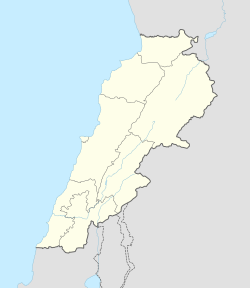Yahchouch
This article will address the topic of Yahchouch, which has gained great relevance in recent years due to its impact on various areas of society. Throughout history, Yahchouch has been the subject of numerous studies and debates, generating increasing interest from academics, experts and the general public. This article seeks to analyze in depth the most relevant aspects of Yahchouch, exploring its multiple dimensions and its influence in different contexts. Likewise, the most recent research related to Yahchouch will be examined, in order to provide a complete and updated view on the topic. Through a critical and reflective approach, it is intended to offer the reader an enriching perspective that contributes to a greater understanding of Yahchouch and its implications in contemporary society.
Yahchouch
يحشوش | |
|---|---|
City | |
 | |
| Coordinates: 34°3′59″N 35°44′11″E / 34.06639°N 35.73639°E | |
| Country | |
| Governorate | Keserwan-Jbeil |
| District | Keserwan |
| Time zone | UTC+2 (EET) |
| • Summer (DST) | UTC+3 (EEST) |
| Dialing code | +961 |
| Website | http://www.yahchouch.org |
Yahchouch (Arabic: يحشوش) is a municipality in the Keserwan District of the Keserwan-Jbeil Governorate in Lebanon. It is located 42 kilometers north of Beirut. Its average elevation is 670 meters above sea level and its total land area is 636 hectares.[1] Yahchouch's inhabitants are predominantly Maronite Catholics and Christians from other denominations.[2]
Places of worship
The municipality has eight Maronite churches (St. Semaan, Wardieh, Saydet Ghoshraya, St. John, St. Takla, St. Therese, St. Bechara and Saydet Shouan) and several other Christian churches.
Families
The Lebanese surname "Yahchouchi" derives from this village. The prominent families of the village are Mouawad, Keyrouz, Zouein, Turk, Assaf, Souaid, Bedrane, Barakat, Atallah, Akil, Tawil, Ghanem, El Jorr, Yahchouchi and others.[citation needed]
The Ghanem family is descended from Moussa Ghanem Al-Ghassani, a descendant of the Ghassanids, who were a Christian dynasty in the Levant under the aegis of the Byzantine Empire. Moussa came to Yanouh in the 9th century and settled there. Later, in 1121, some of his descendants moved to Lehfed. Finally, Sarkis Ghanem moved from Lehfed to Ftouh Keserwan during the 17th century and settled there.
Etymology
The origin of the word would come from the Aramaic Syriac and means "the injured god" because the Syriac god Tammuz (also called Adonis in Greek mythology) died in the Ibrahim river which crosses the village of Yahchouch.
Landmarks
Yahchouch is home to the Jabal Moussa reserve and to the Chouwen River.
References
- ^ "Yahchouch". Localiban. Localiban. 2008-01-22. Retrieved 2016-03-29.
- ^ "Elections municipales et ikhtiariah au Mont-Liban" (pdf). Localiban. Localiban. 2010. p. 19. Retrieved 2016-02-12.

